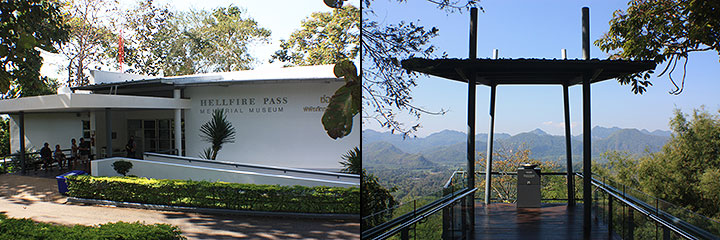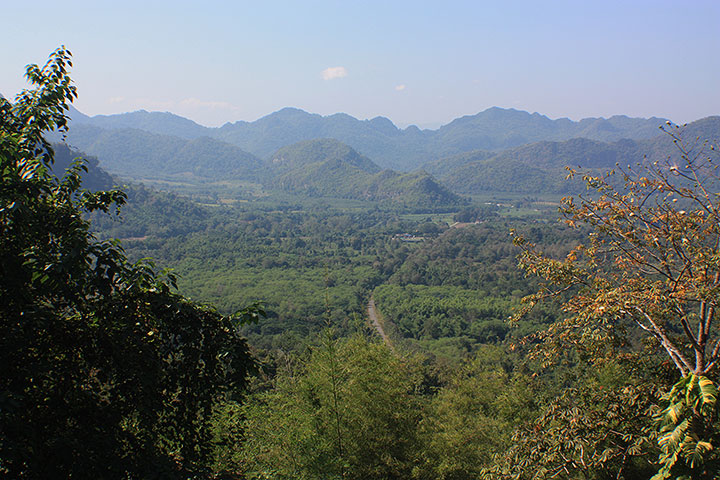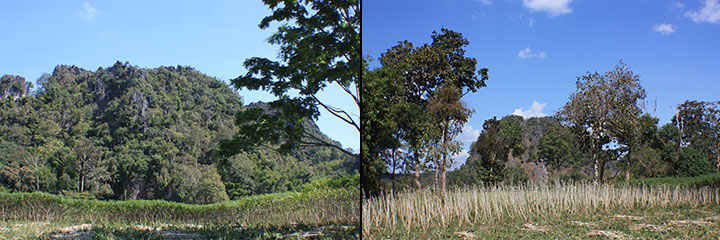I had my second vacation day in Kanchanaburi all figured out when the Road To Mandalay Rally intervened – again. “Would I check a piece of road and route instructions?” the organizers asked. Well, as it turned out, the route they’d planned wasn’t so different than my plans, except it didn’t leave any time for sightseeing.
I mentioned in yesterday’s article that a young Australian hotel guest decided she’d like to join me. She actually seemed quite excited at the thought of being bounced around on rough roads for several hours. Strange creatures these Aussies 🙂
Anyhoo, before we set off, I explained the general idea of tulip diagrams, that we needed to check the distances between them, check that the tulips did in fact accurately describe the route, and that I had no idea where we were supposed to start, because no one had thought to tell me!
That problem was easily solved because the second tulip was at the Hellfire Pass Museum, and the first was 11.7kms before. So, we left the hotel quite early, headed out of Kanchanaburi to the museum, and then 11.7kms backwards. No, we didn’t actually go backwards!
Day 12 of the rally is supposed to be one of the more relaxing days. Competitors can drive to the museum, as we did, and then spend a couple of hours visiting, as we didn’t! But we did use their facilities. In fact, we had to make a donation in order to leave them a donation, so to speak!
From Wikipedia…
“Hellfire Pass is the name of a railway cutting on the former ‘Death Railway’ in Thailand which was built with forced labour during the Second World War, in part by Allied prisoners of war. The pass is noted for the harsh conditions and heavy loss of life suffered by its labourers during construction. Hellfire Pass is so called because the sight of emaciated prisoners labouring at night by torchlight was said to resemble a scene from Hell.
“Hellfire Pass in the Tenasserim Hills was a particularly difficult section of the line to build. It was the largest rock cutting on the railway, coupled with its general remoteness and the lack of proper construction tools during building. A tunnel would have been possible to build instead of a cutting, but this could only be constructed at the two ends at any one time, whereas the cutting could be constructed at all points simultaneously despite the excess effort required by the POWs. The Australian, British, Dutch and other allied Prisoners of War were required by the Japanese to work 18 hours a day to complete the cutting.”
 The Museum is almost at the top of the hill, looking down into the pass. It’s a long walk down to the railway level, which by the way, is no longer used. I’ll do it another time, and report back. Our mission was rather less energetic. We needed to be sure the parking lot is large enough for seventy cars. It is!
The Museum is almost at the top of the hill, looking down into the pass. It’s a long walk down to the railway level, which by the way, is no longer used. I’ll do it another time, and report back. Our mission was rather less energetic. We needed to be sure the parking lot is large enough for seventy cars. It is!


From there our route took us further uphill, with not too many junctions to check, so we had time to build the basics of a friendship, discovering along the way that despite the age difference, not to mention the fact we were born on opposite sides of the planet, we actually had a lot in common.
(Does a planet have sides? If not, then what? Discuss.)
But then we had to work. Roughly at the place shown as Tha Kha-nun on the Google Earth screen capture (below) the road was mostly twisty gravel, until we descended to the dam at the bottom of the Sinakharin reservoir.

There were many small junctions and places where the gravel stopped and then restarted, so with that amount of detail it all covered several pages of tulips. Surprisingly there weren’t too many places where we could get a view of the mountains or the reservoir. The undergrowth at the sides of the roads was just too tall and thick. But we did find this nice view while we munched some cookies that served as lunch.

And, there are good views of the reservoir from the dam, where rally competitors are allowed to make their second break of the day…

From there, it was an easy run back into Kanchanaburi.
It was an interesting, and when work permitted, a fun day. I was left with a few thoughts…
- Once again, the horrors of the construction of the Death Railway were very evident
- Also not for the first time, I couldn’t figure why anyone would want to drive a vintage or classic car over the kinds of roads we travelled, and
- Route checking was a helluva lot easier with two people in the car. Sam did a great job, considering a day earlier she had no idea what to expect. I must have been less of a pain in the ass than usual because she hitched a ride back to Surat Thani the next day, so we had two days of blah, blah, blah, covering every subject under the sun.
